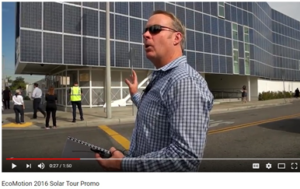November 2017 – Volume 19, Issue 8: Honoring Milestones and Roots
In This Issue
Flanigan’s Eco-Logic
Touring LA’s Most Innovative Energy Projects
COP23 – a Salute!
New Zealand’s Billion Trees
Tesla Jumps Into Trucking
Landfill Energies
“California Goes Green” Book Review

Flanigan’s Eco-Logic: Honoring Milestones and Roots
It’s not every day that you turn 60. My big day was November 1st and boy did my heart get charged with love. Far from fearing the milestone, I embrace it. I am 60 and happy to have lived this long! Thanks to family and friends and neighbors, my weekend celebration in Snowmass was super special, and touching. While I did not want a big focus on me, the toasts and roasts filled my soul with something really precious.
So I take stock of my life, my roots and current situation: What an upbringing that I have had. What great travels and mentors. I’ve been involved in so many cool, green projects. I am in love with a partner with whom I share all trials and tribulations. Fortunately we laugh a lot. I am in love with my children; they sure had fun roasting their poor ole pa! I am in love with my brothers who have been best friends for life. I am blessed to have guy friends like none other. And I have neighbors that share my love of the Rocky Mountains.
 We play music, we soak in the hot springs. We eat, drink, laugh, and dance. I feel myself being spoiled: Is there such a thing as too much love? Too much praise? I make awkward attempts to deflect all this goodness; I’m a self-professed “Average Joe.” I am stunned. I am totally grateful. I let my worries about life slide a bit. Who cares about those work duties and deadlines? They’ll be there when I get back. I am in a 72-hour bliss.
We play music, we soak in the hot springs. We eat, drink, laugh, and dance. I feel myself being spoiled: Is there such a thing as too much love? Too much praise? I make awkward attempts to deflect all this goodness; I’m a self-professed “Average Joe.” I am stunned. I am totally grateful. I let my worries about life slide a bit. Who cares about those work duties and deadlines? They’ll be there when I get back. I am in a 72-hour bliss.
Touring LA’s Most Innovative Energy Projects
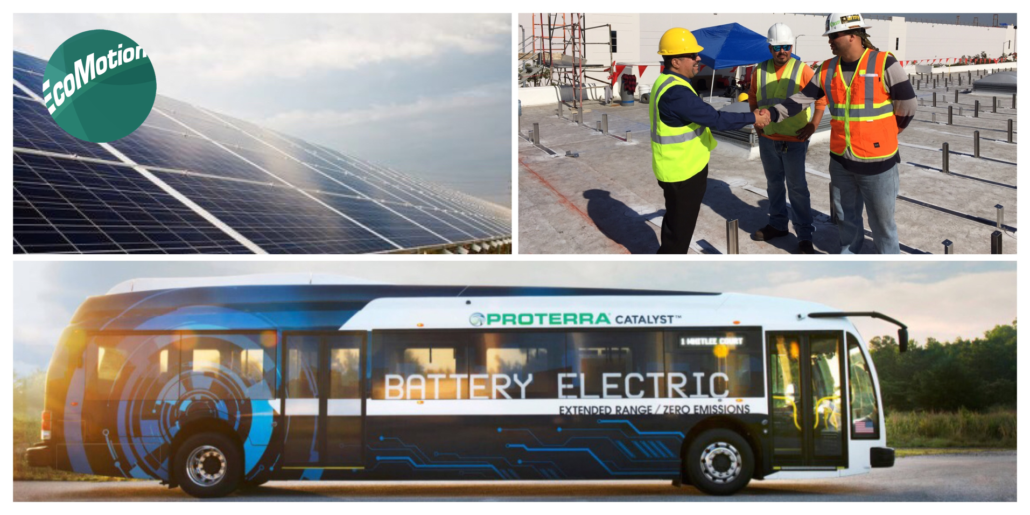 Like you, I get glimpses of innovative energy projects throughout Los Angeles. Three cheers! What progress! Who built that system? Last year, EcoMotion turned that curiosity into a potent tour.
Like you, I get glimpses of innovative energy projects throughout Los Angeles. Three cheers! What progress! Who built that system? Last year, EcoMotion turned that curiosity into a potent tour.
Our 2016 Solar Innovation Tour began by climbing courses of scaffolds to see the world’s largest rooftop solar array under construction; 16.5 MW in San Pedro. From there, we went to a school dominated by a massive vertical solar wall. We visited the Electrical Training Institute where electricians learn how to meld solar with storage to form microgrids.
Next stop on the tour was Cathay Bank with its award-winning solar ports designed by EcoMotion and Gensler Architects. Nice rooftop view. Has anyone seen the hillside solar array in the Arroyo Seco? We were hosted by the Christian Scientist convalescent center and the solar company that mastered the dramatically steep installation. To wrap it all up, happy hour at the Bunker Hill Bar and Grill. On time, on point, great inspiration for all. Here’s a link to a 2-minute video on last year’s tour:
Join us for EcoMotion’s Second Annual Energy Innovation Tour on December 7th, 8:00am – 4:30. This year we broaden our focus from solar to storage and mobility. Proterra has offered us an E-Bus factory tour. We’re going to visit Tesla too. A total of five sites that day is planned.
Space is limited… so make your reservation today. The $75 price per person includes continental breakfast, transportation, project fact sheets, lunch, hors d’oeuvres, and cocktails.
COP23 – a Salute!
EcoMotion salutes those governmental and non-governmental parties that descended on Bonn, Germany from November 6 – 17 for COP23. More so, we salute those leaders and delegates that have come year after year to the Conference of Parties to hammer out the rules of the road for global climate protection. This is hard and important work.
The business of global climate protection is complex, sensitive and critical. As Jerry Brown said in Bonn, “We have time, but not much time.” Fiji was the first island nation to preside over a COP, a country that “brings a powerful moral authority to the role after being forced to relocate whole village due to sea level rise.”

Calls for rapid progress at COP23 in Bonn
Officials and others from nearly 200 countries convened in Bonn, the birthplace of Ludwig van Beethoven, with the clear objective of “making progress for a successful, inclusive, and ambitious implementation” of the legally-binding Paris Agreement.
Syria announced last week that it would commit to the Paris climate agreement, leaving only the U.S. out of the accord. Even North Korea has signed on. Many U.S. state, regional, and city leaders are working overtime to make up for U.S. federal recalcitrance, and to more than counterbalance the administration’s “fossil fuel puppets,” including Rex Tillerson and Scott Pruitt, two men accused of “trying to bully the world with their oily agenda.”

The Fiji Pavilion in Bonn
Just as nations are key; local governments are foundational. Regional and city leaders came for the “Climate Summit of Local and Regional Leaders.” At the Summit, a major side event to COP23, the Bonn-Fiji Commitment was approved by acclamation “to deliver the Paris Agreement at all levels.” The Summit was attended by more than 330 political leaders and 1,000 delegates.
EcoMotion thanks all those in Bonn for moving the full-scale implementation of climate protection forward. We appreciate national actions. And we thank local governments for promoting the power of location actions – eco-motions – to the international level. Then there are citizens of all stripes making their voices heard in Bonn. They are singing from the heart. And we thank all officials and delegates at COP23 for their leadership and dedication to global collaboration.
New Zealand’s Billion Trees

NZ Prime Minister Jacinda Ardern
On October 26, 2017, Jacina Ardern became the 40th Prime Minister of New Zealand. She is the youngest prime minister in New Zealand in 150 years, and the youngest current female head of state worldwide. Ardern intends to spend $1 billion a year for ten years to plant 100 million trees a year to achieve her Billion Tree challenge goal to sequester greenhouse gases.
Tree planting is but a part of Ardern’s platform of progressive policies: The 37-year old Prime Minister and Labour Party chief intends to boost the minimum wage, to offer free doctors visits for all children under 14 years of age, and to review and reform of Reserve Bank Act.
Currently more than 80% of New Zealand’s power comes from renewable sources, primary hydropower, geothermal, and wind. Ardern wants to make it 100% by 2035. She’s intent on creating an independent climate commission, establishing emissions trading, and tapping solar power as a means of doing so. Solar currently provides only 0.1% of the nation’s power generation.

Forrest on the North Island of New Zealand
The tree planting effort will be managed by the country’s new forestry service headed up by Shane Jones. According to Jones, currently 50 million are planted each year and foreign ownership of forests is “out of control.” Native trees will be acting as carbon sinks to counter climate change. Trees will be planted on Maori-owned lands to boost jobs.
So how do trees sequester carbon? Trees capture carbon and convert it into trunks, branches, roots and leaves through the process of photosynthesis, Carbon is stored in trees’ biomass. The rule of thumb is that a mature tree absorbs CO2 at a rate of 48 pounds per year. Thus an acre of forest offsets about two cars’ worth of emissions. A year 2000 IPCC report suggested that sequestration through tree planting could sequester about 1.1 gigatons a year, about 2% of the 50 gigatons of global greenhouse gas emissions.
So what is the greenest tree? Which one should you plant in your backyard? Unfortunately, experts relate that no one size fits all, but generally, the bigger the tree, the better. Think big trunk diameters and dense wood. For instance, Red Mulberry trees and Laurel Oaks sequester 69.5 pounds each year, versus, 36.8 pounds for moderate growth hard woods, and 16.8 pounds for slow pokes. Similarly, leaves are better than needles, thus deciduous trees are preferable to conifers. Then there is the rate of growth, a function of soils and climate. For instance, there is much faster growth in equatorial regions than Vermont.
Find which large leafy hardwoods are indigenous to your region. In New England you can’t go wrong with Yellow Poplars, Scarlet Oaks, London Planes, or American Sweetgums. In New York City, the Yellow Poplar (also known as the tulip tree) was the “sequestration champion,” socking away an impressive 137.26 pounds per year. The runner-up? The European Beech at 112.39 pounds/year.
Tesla Jumps Into Trucking
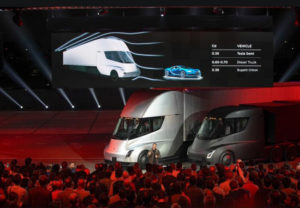
Elon Musk at the unveiling in Hawthorne, CA
Last night, Elon Musk blew everyone away once again. Folks knew it was coming, his foray into the world of trucking. He’s all about carbon-free solutions. Trucks make up 7% of the vehicles on American roads and 20% of transportation greenhouse gases. To address this climate reality, voila, the “Tesla Semi.” Musk also plans to build a network of solar-powered megachargers that will charge the batteries to a 400-mile range in 30 minutes.
But no one anticipated Musk’s announcement to be this good. He announced last night that the “Tesla Semi” that will go into production in 2019. It exceeds all expectations: most notable is its 500-mile range. Within a day of the unveiling, Walmart announced that it will buy 15 Semis to pilot the technology in its 6,000-truck fleet.
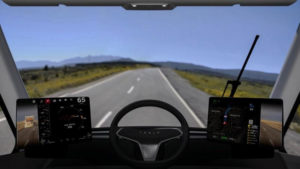
View from the semi’s cockpit
From the outside, the Semi’s carbon fiber cab is smooth and aerodynamic. It cuts the wind more efficiently. Behind the scenes, the truck is high tech: Sensors monitor jackknifing and adjust power to the individual wheels to keep in line. Autopilot is standard.
The stats just keep rolling out: The Semis can go from zero to sixty in 5 seconds; and 20 seconds with an 80,000-pound load. Their torque will allow them to zip up hills, where conventional diesel’s bog down. The trucks’ cabs allow operators to stand or sit; there are large, interactive touchscreens on both sides of the driver.
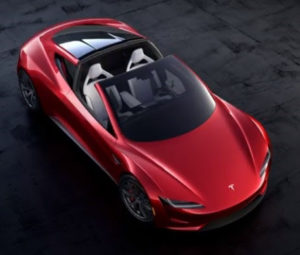
The Tesla Roadster with removable glass roof
Like his solar roof tiles, Musk claims that the Semis will cost less to operate overall than diesel semis. The Tesla is anticipated to cost $ 1.26 per mile to operate, versus diesels at $1.51 per mile. The purchase price will be higher for the Semi, and the operating and maintenance costs will be less over time. The trucks have massive battery banks and four independent motors, two for each axle. The Semis will be guaranteed for a million miles.
Meanwhile, and in Act 2 of his Apple-like product announcement, Musk promised “insane specs” for a new sports car, a four-seater “Roadster” that can go from zero to sixty in 1.9 seconds, faster than the average Formula 1 car. Its top speed will be “somewhere north” of 250 miles per hour. And the car will have 620 miles of range thanks to a 200-kilowatt-hour battery pack, twice the size of most Model S battery packs. Oh, and its cost? A mere $200,000 for the Roadster; a $50,000 down payment.
Landfill Energies

Landfills like these get turned into brownfields
Americans dispose 4.4 pounds of waste per capita per day. Fully 64% of it is landfilled; 164 millions tons each year goes into our nation’s 2,000 landfills. There, and in time, bacteria breaks down organic matter, releasing methane. Landfills are the third largest source of methane emissions in the United States. And methane is a potent greenhouse gas (GHG), with 23 times the global warming potential of carbon dioxide.
Methane Production: Landfills are ripe with energy! Wastes of all kinds enter the landfill, then subsurface microbial decomposition of organics, volatilization, and chemical reactions take place over the course of 10 – 50 years. Potent landfill gases are released, typically a mix of 45% CO2 and 55% methane. Given this environmental threat, and abundant source of energy, extraction wells and gas collection piping systems are built at landfills to turn waste into an asset… power generation with a free fuel.
The first landfill gas energy projects were in Wilmington and Sun Valley, California in 1979. Now more than 630 landfills generate 16.5 billion kWh of electricity each year and deliver 317 million cubic feet per day of landfill gas to direct use applications. The EPA has identified another 450 landfill sites for potential energy projects.
Solar: It’s estimated that there are 10,000 municipal landfills in the country, most of which are closed, many of which are located in proximity to the existing utility grid, making solar and wind system interconnection affordable. The number of operating landfills had fallen from 8,000 in late 1980s to less than 2,000 by mid 2000s.
There are a lot closed landfills out there, with few viable use patterns given their semi-toxic nature. It’s not easy to use waste sites. Housing is out. So what to do? Sports fields? Allow kids to play there? Sounds hazardous. Clean energy development – a semi-industrial process sounds about right. Is this recycling of closed landfills? The Massachusetts Department of Environmental Protection calls it “repurposing!”
Closed landfills are capped with a geo-membrane. On top of that typically goes a 4-foot layer of sand for drainage. Then vegetation is introduced and nurtured. Typically it takes 10 – 12 years for settling to be complete; the more organic the waste the longer it takes. Once the settling has taken place, and to avoid penetrating the geo-membranes, solar companies use ballasted racking systems that float above the protective layer, bearing a 25 cent per kWh marginal cost.
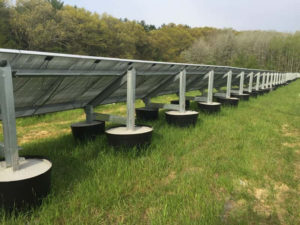
Pour in Place Solar from Gamechange Solar
The Scituate Landfill Solar Project was built on a 29-acre landfill that operated from 1976 – 1999. The landfill is now relatively flat and has a gentle south-facing slope ideal for solar. Scituate considered a ball field for the site, but solar and wind now make the City 100% renewably powered. Functionally, the land is leased to the solar developer – Brightfields – for $1 a year. Today, 10,560 panels with 3 MW of capacity cover 6.1 acres and produce 3.8 million kWh/year. The developer in turn provides the City with 8-cent/kWh power.
Scituate Solar Source: Brightfields Development
As of February, 2013 there were 15 solar PV farms on American landfills producing 30 MW of power. The number is growing. The U.S. EPA has pre-screened 1,600 landfills for solar potential. New England has a lot of relatively flat landfills. New York is planning a 10 MW solar farm on 47 acres of the Staten Island 2,200-acre landfill, the nation’s largest.
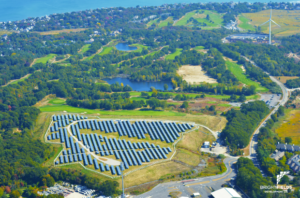
Vermont’s first solar landfill project is now complete, a 2.7 MW system on the only active landfill in the state. Solar was built there on the buffer zone, required land to separate landfill from other usable land. Four MW of energy storage was added too. Now Green Mountain Power is building a solar system on a 9.5 acre closed landfill in Rutland, Vermont.
New technologies are poised to support landfill solar: GameChange Solar’s “pour in place” ballasted ground system reduced costs by using stronger steel that enables longer spans and less foundations, thus less concrete, while reducing installation costs by up to 10 cents per watt, keeping landfill solar costs in line with traditional, pile-driven ground mounts.
Wind:Generally, wind and landfills don’t mix. Wind picks up trash and blows it everywhere. Thus most landfills are located in non-windy locations by design. That said, wind turbine towers rise high above the ground, tapping into wind currents. In the United Kingdom, a Spanish engineering firm that operates 100 landfills is planning to invest $152 million in 80 MW of wind energy capacity at UK landfill sites.
“California Goes Green” Book Review
 “California Goes Green: A Roadmap to Climate Leadership,” is a new and important book by Michael Peevey and Diane Wittenberg. Peevey was most recently President of the California Public Utilities Commission; Wittenberg founded the California Climate Registry and is currently chair of the California State Parks and Recreation Commission. For anyone wondering how California became such a green state, this is a must read. Featuring profiles of California environmental leaders, the book provides behind-the-scenes insights to how effective environmental policy has been forged while California’s economy thrives.
“California Goes Green: A Roadmap to Climate Leadership,” is a new and important book by Michael Peevey and Diane Wittenberg. Peevey was most recently President of the California Public Utilities Commission; Wittenberg founded the California Climate Registry and is currently chair of the California State Parks and Recreation Commission. For anyone wondering how California became such a green state, this is a must read. Featuring profiles of California environmental leaders, the book provides behind-the-scenes insights to how effective environmental policy has been forged while California’s economy thrives.
The book begins in Paris in December of 2015, in a “gilded hall” with “cascading chandeliers,” and Governor Jerry Brown serving as the world’s climate leader addressed the group called “Under 2 MOU,” the Subnational Global Climate Leadership Memorandum of Understanding. California and other “subnationals” are leading the way to climate protection, representing ~100 jurisdictions with 600 million people and one quarter of the world’s economic activity. Across town, Governor Arnold Schwarzenegger was hosting R20, another public-private partnership (the nonprofit Regions of Climate Change) that has spearheaded cool roofs, street lighting, and other efficiency measures across Africa, Mexico, Algeria, Europe and the United States to combat climate change.
Today, California is a world-class model for effective climate protection. The book details how we decoupled energy use and economic growth. The State’s current target of reducing greenhouse gases 40% below 1990 levels by 2030 is both “the most ambitious and achievable target in North America.” In forty years, California has moved from having coal plants, to closing them, to disallowing imports of coal-fired capacity, and now to generating 30% with renewables, with a 50% by 2030 target. (A new report suggests this may be attained by 2020.) We have high rates, but low bills. We have the best building standards – thanks to Title 24 — and the most electric vehicles.
The root story in “California Goes Green” begins with smog, “a soup of smoke and fog.” When it became apparent in Los Angeles in the 1940s, no one knew where it came from. The term “smog” was appropriated from London. A Caltech professor, Dr. Arie J. Haagen-Smit, sucked millions of tons of air through giant fans in his lab to analyze the problem, and he figured it out. Much smog was the result of auto tailpipe emissions. And it was getting worse and worse.

Smog over Los Angeles
Fighting smog became a bipartisan issue. Everyone, rich and poor, red or blue, regardless of persuasions and color… everyone was affected by smog. Cleaning the air became the rallying point of California’s environmental movement. “State Republicans and Democrats fight polarized battles on many issues, including climate, but over the decades, leaders of both parties have agreed that California is too exposed to environmental problems to ignore their consequences.” This bipartisan environmental ethic spawned other resource protections such as the Coastal Commission.
Peevey and Wittenberg worked for Southern California Edison for many years, Peevey ultimately serving as its President. The book recounts how in 1980 Southern California Edison took bold steps and stepped up in support of renewables. Among other accomplishments, Edison built the pioneering Solar One “power tower.” There was remarkable leadership under CEO Bill Gould… a utility visionary who foresaw the transformation of utilities away from central thermal stations.
Climate leadership demands a big focus on cars. Wittenberg was president of Edison EV, an unregulated Edison subsidiary and cutting-edge utility initiative designed to transform mobility in Southern California. Fran Pavley, a middle school teacher of 26 years, is cited for her leadership in the California Assembly and Senate. She effectively fought for Low-Carbon Transportation Fuel Standards that cut fuel carbon intensity by 10%. California Goes Green touts the rise of Tesla and Elon Musk’s other companies including Hyperloop that have created more than 20,000 jobs in California while promoting local, regional, state, national, and global climate solutions.
California Goes Green takes the reader behind the scenes during the California Power Crisis. CPUC Commissioner Dan Fessler was “passionate about the concept of free markets… He was also determined to follow Margaret Thatcher’s United Kingdom down the path to electricity deregulation.” That led to the Blue Book that ushered in retail electricity competition in California. SCE and PG&E were forced to sell their generating assets in 1996. There were new market entrants; through retail competition SCE lost 13% of its retail sales to companies like Mike Peevey’s New Energy Ventures.
Ultimately “deregulation” was hamstrung. The free-market for power never sufficiently materialized, this led to skyrocketing wholesale power prices and ultimately the California Power Crisis of 2001 that would ultimately cripple the State and take down Governor Grey Davis. California Goes Green gives us an inside look as Mike Peevey, Dave Freeman, and others were summoned by the Governor to secure the State’s power resources and reliability.
Peevey and Wittenberg state that California’s leadership can be traced to a number of factors. Setting up three world-class environmental and energy agencies: the California Air Resources Board, the California Public Utilities Commission, and the California Energy Commission, has proven essential. This triumvirate, rather than competitive, is a force, with policies grounded in solid research and strong ties to academia, national labs, and prominent universities. There are celebrity endorsements, such as Leonardo de Caprio driving up to a premier in a hybrid Fisker. Environmental groups, notably the Natural Resources Defense Council, have been important collaborators, enabling bills such as AB 32, California’s world-renowned Global Warming Solutions Act.
Can other states follow suit? Yes, say the authors. But they must follow a deliberate path based on a broadly shared vision. In addition to policy makers, there are roles for a all kinds of influential leaders, be they actors, musicians, sports figures, or religious heads…to support the movement. California’s success underscores the need for and value of broad collaboration to turn vision into reality.
In my view, California Goes Green is mandatory for public policy enthusiasts and practitioners in the green space. This is how it was done, how it worked, and how it California’s leadership continues to grow in international importance. California, by national default, is the nation’s climate leader. This didn’t happen over night; there’s a rich 40-year history of greening in the making. Get it on Amazon.

